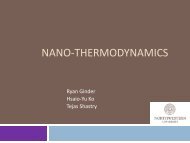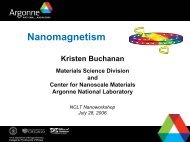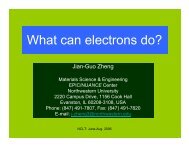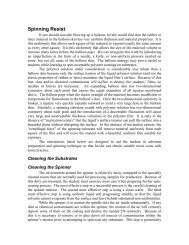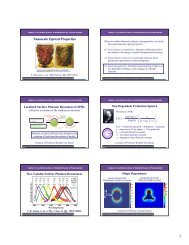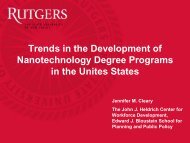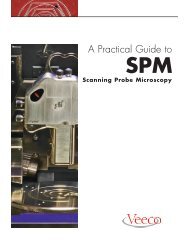An Introduction to Mesoscopic and Nanometer Scale Physics (PDF)
An Introduction to Mesoscopic and Nanometer Scale Physics (PDF)
An Introduction to Mesoscopic and Nanometer Scale Physics (PDF)
You also want an ePaper? Increase the reach of your titles
YUMPU automatically turns print PDFs into web optimized ePapers that Google loves.
<strong>An</strong> <strong>Introduction</strong> <strong>to</strong> <strong>Mesoscopic</strong><br />
<strong>and</strong> <strong>Nanometer</strong> <strong>Scale</strong> <strong>Physics</strong><br />
Freshman Seminar:<br />
Nanoscience <strong>and</strong> Nanotechnology<br />
January 26, 2006
A brief review of quantum mechanics<br />
Quantum mechanics tells us that the fundamental building blocks of<br />
nature can be thought of as both particles <strong>and</strong> waves.<br />
What determines when must we take in<strong>to</strong> account the wave nature of<br />
particles?<br />
λ = h / p<br />
de Broglie wavelength<br />
If the de Broglie wavelength of the particle is less than its physical<br />
dimensions, then classical mechanics provides a good description.<br />
For example, λ of an electron of mass 9.11 x 10 -31 kg traveling at 3<br />
x 10 6 m/s is ~0.24 nm, compared <strong>to</strong> the electron radius of<br />
~3 fem<strong>to</strong>meters.<br />
A 1 cm 3 droplet of water travelling at the same velocity has a<br />
wavelength of ~2 x 10 -37 m, compared <strong>to</strong> its physical extent of<br />
~ 1 cm.
Wave Mechanics: Double slit experiment with waves<br />
Consider the classic double slit experiment. We have a wave of some<br />
nature (light, for example, but it could also be water waves). If we have<br />
only slit 1 uncovered, we obtain the intensity pattern I 1 . If we have only<br />
slit 2 uncovered, we obtain I 2 . If we have both uncovered, we obtain the<br />
red curve I 12 , which is of course the interference pattern of the waves<br />
coming from slits 1 <strong>and</strong> 2.<br />
I 1<br />
I 2<br />
I 1,2<br />
1<br />
y<br />
2
Double slit experiment with electrons<br />
Now consider the same experiment, but with a gun which fires electrons<br />
as a source. Instead of a screen, we use something which counts<br />
individual electrons. Each time an electron hits the screen, we count the<br />
event <strong>and</strong> where it occurred. By counting the number of hits on average<br />
at a particular value of y, we obtain a probability distribution of the<br />
electrons as they hit the screen.<br />
electron<br />
gun<br />
1<br />
y<br />
2
Interference of electrons<br />
Now electrons, cannot be split up (at least not in this experiment). When we<br />
detect an electron, we detect a whole electron. We then make the very<br />
reasonable assumption that if an electron goes from the electron gun <strong>to</strong> the<br />
detec<strong>to</strong>r screen, it goes through either slit 1 or slit 2. It cannot split itself up <strong>and</strong><br />
go through both slits at once. If we measure again the probability distribution<br />
with each slit closed in turn, we obtain the distributions shown below.<br />
electron<br />
gun<br />
1<br />
2<br />
y<br />
Simulation
Interference of electrons<br />
When we let both slits be open, <strong>and</strong> measure the probability distribution, we<br />
find that it looks like what is shown below, which is very similar <strong>to</strong> the<br />
probability distribution for a wave. Hence, although the electrons appear <strong>to</strong><br />
arrive as particles, in one single “lump” which contains the entire electron, the<br />
final distribution pattern looks very similar <strong>to</strong> what we found for the intensity<br />
of a wave. Hence the electrons appear <strong>to</strong> have both particle like <strong>and</strong> wave like<br />
properties.<br />
P 12 ≠ P 1 + P 2<br />
P 1<br />
P 2<br />
P 1,2<br />
electron<br />
gun<br />
1<br />
y<br />
2
Interference of electrons-effect of observation<br />
One can obtain an interference pattern with only one electron, which can take two<br />
possible paths from the gun <strong>to</strong> the screen. However, if we put a detec<strong>to</strong>r at one<br />
slit <strong>to</strong> determine which path the electron takes, then we no longer obtain the<br />
interference pattern, but only the two gaussian distributions. Thus, the act of<br />
observation forces the electron <strong>to</strong> choose one of the two possible paths (or<br />
states), or put another way, the act of measurement affects the observation, a<br />
peculiar property of quantum systems.<br />
P 1<br />
P 2<br />
P 1,2<br />
electron<br />
gun<br />
1<br />
y<br />
2
Wave nature of particles<br />
Like other waves, quantum mechanical waves of particles are described<br />
by functions that satisfy a wave equation, in this case, Schrödinger’s<br />
wave equation<br />
− h2<br />
2m<br />
d 2 ψ<br />
+ V (x)ψ = Eψ<br />
2<br />
dx<br />
where m is the mass of the particle, <strong>and</strong> E the energy of the particle,<br />
<strong>and</strong> V(x) the potential. The wave function ψ(x) is in general a complex<br />
function, with an amplitude <strong>and</strong> a phase<br />
ψ(x) = ψ(x) e iϕ(x )<br />
Once ψ(x) is known, one can determine all the properties of the system.<br />
For example, the probability of finding a particle at a position x is given<br />
by<br />
P(x) = ψ(x) 2
Quantum Tunneling<br />
ψ(x)<br />
V(x)<br />
Classical particle<br />
Quantum description<br />
x<br />
For x
Quantum tunneling through a barrier<br />
ψ(x)<br />
V 0<br />
V(x)<br />
Classical particle cannot penetrate<br />
barrier<br />
x=0 a<br />
Quantum particle: finite probability on opposite side of<br />
barrier- particle tunnels through barrier<br />
x<br />
Potential barrier of height V 0 <strong>and</strong> width a, where energy E of particle is less than V 0 .<br />
For xa, solution same as before.<br />
For 0>x>a, Schrödinger’s equation is<br />
− h2<br />
2m<br />
d 2 ψ<br />
dx 2 + V 0ψ = Eψ<br />
⇒<br />
Solutions are ψ(x) = Ce αx + De −αx<br />
h 2<br />
2m<br />
d 2 ψ<br />
dx + (E −V 0)<br />
2 14 24 3<br />
ψ = 0<br />
< 0<br />
Solutions in barrier are exponentially decaying<br />
Tunneling simulations
More about wave functions<br />
Classically, can specify both position x <strong>and</strong> momentum p with infinite accuracy<br />
Quantum mechanics?<br />
Consider wave function ψ(x)= ψ 0 e ikx<br />
Corresponds <strong>to</strong> a particle with definite momentum<br />
p = hk<br />
What about position?<br />
Probability density |ψ(x)| 2 =|ψ 0 | 2<br />
independent of x<br />
cannot tell position of particle at all<br />
If we know the momentum p exactly, the position x of the particle is completely<br />
unknown (<strong>and</strong> unknowable)<br />
Conversely, if we know the position of a particle exactly, its momentum is completely<br />
unknown
More about wave functions<br />
Suppose we want <strong>to</strong> know the position of a particle accurately. How do we define<br />
its wavefunction?<br />
ψ(x)<br />
Particle localized within a distance ∆x<br />
ψ(x) is a superposition of waves of different<br />
wavevec<strong>to</strong>rs over some range<br />
(Wave packet)<br />
ψ (x) = sin(2πk 1<br />
x) + (1/ 2)sin(2πk 2<br />
x) + (1/ 2)sin(2πk 3<br />
x)<br />
∆x<br />
What about momentum p?<br />
Not well defined..some average of k 1 , k 2 , k 3 .<br />
|ψ(x)| 2<br />
Uncertainty in both position <strong>and</strong> momentum<br />
Both momentum <strong>and</strong> position only known <strong>to</strong> some<br />
uncertainty ∆x, ∆p
Heisenberg uncertainty principle<br />
Impossible <strong>to</strong> know both momentum <strong>and</strong> position of a particle precisely<br />
Minimum uncertainty is given by<br />
∆x∆p ≥ h<br />
If position is known precisely (∆x=0), then momentum is completely unknown (∆p=∞)<br />
If momentum is known precisely (∆p=0), then position is completely unknown (∆x=∞)<br />
In general, both position <strong>and</strong> momentum are not precisely known<br />
True for non-commuting variables
Time evolution of quantum states<br />
Quantum mechanics tells us that solutions of Schrödinger’s equation with<br />
definite energy evolve in time according <strong>to</strong> the equation ψ(t) =ψ(0)e −iEt / h<br />
Consider a superposition of two states ψ 1 <strong>and</strong> ψ 2 . The time dependence<br />
is given by<br />
ψ(t) =ψ 1<br />
(t) +ψ 2<br />
(t) =ψ 1<br />
(0)e −iE 1t / h +ψ 2<br />
(0)e −iE 2t / h<br />
As a function of time, the particle will oscillate between the two<br />
eigenstates<br />
QuickTime <strong>and</strong> a<br />
Microsoft Video 1 decompressor<br />
are needed <strong>to</strong> see this picture.
Quantum mechanics <strong>and</strong> measurement<br />
Wave function is frequently superposition of different components with well<br />
defined quantum numbers<br />
Example<br />
Wave function<br />
ψ (x) = sin(2πk 1<br />
x) + (1/ 2)sin(2πk 2<br />
x) + (1/ 2)sin(2πk 3<br />
x)<br />
Measurement of momentum can give three possible values<br />
p 1<br />
= hk 1<br />
p 2<br />
= hk 2<br />
p 3<br />
= hk 3<br />
What is observed in a single measurement? Either p 1<br />
or p 2<br />
or p 3<br />
What is the average momentum recorded after many measurements?<br />
Average determined by weights of different momentum functions<br />
p ave = (2/3) p 1<br />
+ (1/6) p 2<br />
+ (1/6) p 3
Superposition of states: In search of Schrödinger’s Cat<br />
Closed box with Cat <strong>and</strong> radiation source inside<br />
Source emits radiation intermittently which<br />
kills Cat<br />
=<br />
Question<br />
With the box lid closed, is the Cat dead or alive?<br />
Can only determine by making a measurement!
In search of Schrödinger’s Cat<br />
Is Schrödinger’s Cat dead or alive ?<br />
?<br />
Cat is in a superposition of two quantum states<br />
ψ cat = +<br />
How do we find out? Open the box <strong>and</strong> look at the Cat<br />
Two possibilities...Cat is either dead or alive (two quantum states with two quantum<br />
numbers)<br />
Act of observation collapses Cat wave function in<strong>to</strong> one of the two superposition<br />
states (dead or alive)!<br />
Quantum mechanically, the act of observation affects the system being observed!
Quantum Two-State Systems: Qubits<br />
Consider an electron, which has a spin angular momentum of 1/2<br />
in units of Planck’s constant<br />
h<br />
According <strong>to</strong> quantum mechanics, components of angular momentum are<br />
quantized-- can only change in units of<br />
z-component of electron spin can have two values: + 1/2 or - 1/2<br />
h<br />
+ 1/2 - 1/2<br />
(Two orientations like a<br />
computer bit -- quantum<br />
bit or “qubit”)<br />
x, y <strong>and</strong> z components of angular momentum are non-commuting variables<br />
if z-component is known exactly, not possible <strong>to</strong> know the x or y<br />
components
Combinations of qubits<br />
Now consider a quantum state involving two electrons<br />
What are the possible spin combinations?<br />
| 1 2 > | 1 2 > |<br />
1 2 > |<br />
1 2<br />
><br />
(4 states)<br />
Usually organize in terms of <strong>to</strong>tal spin<br />
Total spin S=1<br />
| 1 2 ><br />
S z =1<br />
| 1 2 > + |<br />
1 2 ><br />
|<br />
1 2<br />
><br />
S z =0<br />
S z =-1<br />
Triplet<br />
states<br />
Total spin S=0 | 1 2 > - | 2 ><br />
1 S z =0 Singlet states<br />
Electrons in state are correlated -- “entangled” states
Einstein-Podolski-Rosen (EPR) Paradox<br />
Suppose we prepare two electrons on Earth in a spin-singlet state (S=0)<br />
| 1 2 > - |<br />
1 2 ><br />
Take one electron of the pair <strong>to</strong> Alice on Venus, take the other <strong>to</strong><br />
Bob on Mars. Let Alice measure the spin of her electron<br />
Suppose Alice measures S z =+1/2. What is the spin of Bob’s electron?<br />
QM tells us that a measurement of Bob’s electron must give S z =-1/2<br />
since the electrons are correlated, even though they are separated by<br />
a very long distance. Alice’s measurement of her electron tells us<br />
the spin orientation of Bob’s electron, even without making a<br />
measurement.<br />
In order <strong>to</strong> remain correlated, the state must retain its coherence
Quantum coherence<br />
Quantum interference in disordered metals: the Aharonov-Bohm effect<br />
Classical charged particle in a magnetic field B<br />
Lorentz force F~ q v B, executes circular cyclotron motion<br />
B<br />
e<br />
No effect in regions where there is no B field
Quantum coherence: The Aharonov-Bohm effect<br />
<strong>An</strong>nulus enclosing magnetic field B <strong>and</strong> magnetic flux Φ<br />
but no magnetic field in electron’s path!<br />
B<br />
e<br />
Magnetic field affects electron phase through magnetic<br />
vec<strong>to</strong>r potential A<br />
Electron wave function<br />
Absence of magnetic field<br />
r<br />
B = ∇ × A<br />
r<br />
With magnetic field, phase modified<br />
ψ ~ ψ 0<br />
e ir p • r =ψ 0<br />
e iϕ<br />
ϕ → ϕ − 2π e h<br />
b<br />
∫<br />
a<br />
r<br />
A • d r
The Aharonov-Bohm effect<br />
ϕ 1<br />
= ϕ 0<br />
− 2π e h<br />
1<br />
b<br />
∫<br />
a<br />
r<br />
A • dr<br />
e<br />
a<br />
B<br />
b<br />
Total phase difference<br />
ϕ = ϕ 2<br />
−ϕ 1<br />
= 2π e h<br />
2<br />
ϕ 2<br />
= ϕ 0<br />
+ 2π e h<br />
∫<br />
r<br />
A • dr<br />
b<br />
∫<br />
a<br />
r<br />
A • dr<br />
Quantum of magnetic flux<br />
= 2π e h φ = 2π φ φ 0<br />
φ 0<br />
= h /e = 4.14 ×10 −15 T-m 2<br />
Electron current periodic in flux, with fundamental period φ 0
Interference of electrons: the Aharonov-Bohm<br />
effect<br />
1<br />
e<br />
B<br />
2<br />
Like Young’s double slit experiment, except phase difference<br />
controlled by magnetic field instead of path length<br />
Smallness of flux quantum φ 0 means that such interference devices<br />
are very sensitive detec<strong>to</strong>rs of magnetic field.<br />
Example: Superconducting Quantum Interference Devices (SQUIDs)<br />
Typical noise levels ~10 µφ 0 /Hz 1/2<br />
For a 1 cm 2 area SQUID, corresponds <strong>to</strong> a magnetic field noise level of<br />
2 x 10 -16 T/ /Hz 1/2
The Aharonov-Bohm effect in disordered metals<br />
1<br />
e<br />
B<br />
2<br />
Strong elastic impurity scattering, electron motion is diffusive<br />
Elastic scattering length L e<br />
~ 10-100 nm<br />
Electron momentum changes at each scattering even,<br />
is interference pattern observed?<br />
Yes! Relevant length scale is electron<br />
phase coherence length L φ ~1 µm<br />
Samples with dimensions< L φ show<br />
quantum interference effects<br />
But coherence can easily be destroyed by interaction with environment:<br />
thermal vibrations, electromagnetic fields, Coulomb interactions, etc.
Quantum interference in disordered metals<br />
Relevant length scale is the electron phase coherence length L φ<br />
Determined by electron-electron, electron-phonon interactions, etc<br />
Increases at low temperatures, but still small! (1 µm)<br />
Need <strong>to</strong> make devices with small dimensions<br />
Electron-beam lithography<br />
measured at low temperatures!<br />
Cryogenic low-noise measurement techniques<br />
Quantum interference is an example of a mesoscopic effect<br />
microscopic < relevant length scale < macroscopic
The Aharonov-Bohm effect in disordered metals<br />
1<br />
e<br />
B<br />
2<br />
h/e oscillations: Webb et al, PRL (1985) h/2e oscillations: Ch<strong>and</strong>rasekhar et al, PRL (1985)
Quantum devices<br />
The operating principles of almost all modern solid state devices<br />
(transis<strong>to</strong>rs, diodes, etc.) are based on quantum mechanical<br />
phenomenon. However, these devices are macroscopic in dimension, <strong>and</strong><br />
involve averages over a very large number (10 23 ) number of incoherent<br />
quantum states.<br />
Two fac<strong>to</strong>rs separate distinctly quantum phenomena<br />
Coherence, or the control or manipulation of the quantum<br />
mechanical phase of the wave function<br />
The ability <strong>to</strong> probe individual quantum states
Quantum operations<br />
Consider a two-level system like the spin 1/2 electron discussed earlier.<br />
To make the notation applicable <strong>to</strong> a variety of two-level systems, we<br />
will denote the two states by |0> <strong>and</strong> |1> (say |0> = <strong>and</strong> |1>= )<br />
| > | ><br />
What sort of quantum operations can we apply <strong>to</strong> such a qubit?<br />
There are an infinite number of one-qubit operations that one can apply<br />
Example: Consider the time evolution of quantum states discussed<br />
earlier. Take the energy of the |0> state <strong>to</strong> be 0, <strong>and</strong> the<br />
energy of the |1> state <strong>to</strong> be E. Then the time evolution<br />
in a time interval t is described by the set of operations<br />
|0> -> |0><br />
|1> -> |1>e iωt<br />
where ω=2πE/h ψ =ψ 0e −iEt / h
Single qubit quantum operations<br />
The time evolution operation can be represented as a matrix that<br />
operates on a general qubit superposition state α|0> + β|1><br />
where θ=ωt<br />
⎛<br />
P(θ) = 1 0 ⎞<br />
⎜<br />
⎝ 0 e iθ ⎟<br />
⎠<br />
⎛<br />
ψ = α ⎞<br />
⎜ ⎟<br />
⎝ β⎠<br />
Other opera<strong>to</strong>rs:<br />
Identity opera<strong>to</strong>r I takes |0> -> |0>, |1> -> |1><br />
Opera<strong>to</strong>r X switches the two states |0> -> |1>, |1> -> |0><br />
⎛<br />
X = 0 1 ⎞<br />
⎜<br />
⎝ 1 0⎠<br />
The X opera<strong>to</strong>r can be recognized as the analog of the<br />
classical NOT opera<strong>to</strong>r<br />
⎛<br />
I = 1 0 ⎞<br />
⎜ ⎟<br />
⎝ 0 1⎠
Double qubit quantum operations<br />
Now consider the following double-qubit operation<br />
|a><br />
|a><br />
|b><br />
|a> ⊕ |b><br />
This gate is defined by the following transformations on the two qubit<br />
states |a b><br />
|00> -> |00><br />
|01> -> |01><br />
|10> -> |11><br />
|11> -> |10><br />
This is called a quantum XOR operation (or gate), also known as a<br />
controlled-NOT gate.
Quantum computers<br />
A classical computer can be constructed entirely from logic gates (in<br />
particular, NAND gates)<br />
A quantum computer can be constructed entirely from quantum XOR<br />
gates <strong>and</strong> single-qubit gates.<br />
How does a quantum computer work?<br />
Prepare a state of n qubits, <strong>and</strong> let it evolve under a set of quantum<br />
operations.<br />
What is the advantage of a quantum computer?<br />
Logic operations occur on n bits simultaneously --><br />
massively parallel computation
Advantages of quantum computers<br />
Example: Fac<strong>to</strong>rization of large numbers (important in cryp<strong>to</strong>graphy,<br />
internet security, etc.)<br />
RSA-129 Challenge problem<br />
15 = 5 x 3<br />
4633 = 41 x 113<br />
1143816257578888676692357799761466120102182 9672124236256256184293570693524573389783059 7123563958705058989075147599290026879543541<br />
=34905295108476509491478496199038 98133417764638493387843990820577 X<br />
32769132993266709549961988190834 461413177642967992942539798288533<br />
Took 8 months, 600 people <strong>and</strong> equivalent of 750 ten-MIPS computers (April, 1994)<br />
For a 300-digit number, a 1 THz classical computer will take<br />
150,000 years<br />
with a 1 THz quantum computer, it will take less than 1 second
Experimental realizations of qubits<br />
A<strong>to</strong>mic <strong>and</strong> molecular systems<br />
NMR on ensembles of spins<br />
A<strong>to</strong>mic energy levels<br />
Trapped ions<br />
Pho<strong>to</strong>ns<br />
Solid state qubits<br />
Electron spins in quantum dots<br />
Superconducting devices<br />
Other systems<br />
Electrons on liquid helium<br />
Spins in semiconduc<strong>to</strong>rs<br />
Nano-electromechanical systems
Fabrication of nanogap devices<br />
High resolution electron beam lithography<br />
e-<br />
Au film<br />
PMMA<br />
Co-PMMA<br />
SiO 2<br />
Si<br />
25-50 nm<br />
best is ~5 nm
Gallery of electron-beam fabricated samples<br />
GaAs 2DEG double-quantum dot<br />
“F-SQUID” Ferromagnetic/superconduc<strong>to</strong>r structure<br />
Ferromagnet/superconduc<strong>to</strong>r/normal metal device<br />
DNA/Au nanoparticle device
Sample measurement<br />
Dilution or 3 He refrigera<strong>to</strong>r<br />
temperatures down <strong>to</strong> 20 mK<br />
..can also apply magnetic fields<br />
Cooling electrons is a problem-loss of<br />
contact with phonons<br />
Need <strong>to</strong> take special care <strong>to</strong> filter<br />
noise, especially radio-frequency<br />
noise<br />
Use home-made resistance bridges <strong>and</strong><br />
electronics<br />
Low measurement currents (20 nA)
Solid state qubits<br />
Double quantum dot in semicondu<strong>to</strong>r 2DEG (Loss <strong>and</strong> DiVincenzo)<br />
Each quantum dot is a qubit<br />
with a spin 1/2 electron<br />
(simplest case)<br />
α|0> + β|1><br />
Exchange interaction creates<br />
coupling, resulting in singlet<br />
<strong>and</strong> triplet states<br />
Need <strong>to</strong> control interaction<br />
prepare states<br />
read out states<br />
Marcus group, Harvard
Superconducting qubits- the Cooper pair box<br />
Superconducting isl<strong>and</strong> isolated by tunnel junctions (charge qubit)<br />
Can control the number of Cooper pairs by varying gate voltage<br />
Slide 38<br />
Two states:<br />
|0> = no Cooper pair on isl<strong>and</strong><br />
|1> = single Cooper pair on<br />
isl<strong>and</strong><br />
Near degeneracy point, superposition<br />
of the two states
Superconducting qubits- flux qubits<br />
(H. Takayanagi, NTT Research)<br />
NTT Atsugi<br />
States controlled by applying magnetic field<br />
Transitions between states can be induced<br />
by radiating with microwave pho<strong>to</strong>ns<br />
E 0 (1)<br />
∆E<br />
Level<br />
splitting<br />
Φ<br />
M<br />
/I p<br />
Qubit<br />
dc-SQUID<br />
Φ/Φ 0<br />
Classical states<br />
Quantum ground state |0><br />
Quantum first excited state |1>
Nano Electro-Mechanical Systems (NEMS)<br />
Doubly Clamped Flexural Resona<strong>to</strong>r<br />
t<br />
L<br />
Clel<strong>and</strong> Group, UCSB<br />
Fundamental<br />
Ω0 E t<br />
= 1. 03<br />
2π<br />
ρ 2<br />
L<br />
Amplitude<br />
1st harmonic<br />
Ω1 = 2.<br />
75Ω0<br />
2nd harmonic<br />
Ω2 = 5.<br />
40Ω0<br />
DC response: ∆z = F / k eff<br />
Fundamental: ∆z = Q F / k eff<br />
Q ~ 10 4 for nm-resona<strong>to</strong>rs<br />
0 2 4 6<br />
Frequency (GHz)
Quantum Behavior in Mechanical Systems<br />
Simple Harmonic Oscilla<strong>to</strong>r<br />
Clel<strong>and</strong> Group, UCSB<br />
E<br />
E = (1/2) kx 2<br />
E<br />
E = (n +1/2) hω<br />
n=2<br />
ω<br />
1<br />
0<br />
Classical<br />
x<br />
Quantum<br />
x<br />
To measure transition:<br />
• k B T < hω : T min » 50 mK ω/2π 1 GHz<br />
• (nearly) quantum limited detection: ε ~ (1-10) hω
Detection of <strong>Nanometer</strong> <strong>Scale</strong> Motion<br />
Clel<strong>and</strong> Group, UCSB<br />
DC Bias<br />
+<br />
RF Drive<br />
C<br />
Beam Motion<br />
Beam motion ∆x changes C:<br />
∆C<br />
=<br />
∂C<br />
∆x<br />
∂x<br />
Voltage V changes Q:<br />
∆Q<br />
= ∆C<br />
⋅V<br />
∆I<br />
I<br />
SET<br />
I ds<br />
Charge ∆Q induces change ∆I:<br />
∆I<br />
∂I<br />
= ∆Q<br />
∂Q<br />
∂I<br />
= ∆x<br />
∂x<br />
Sensitivities of 10 -16 m/Hz 1/2<br />
at 1 GHz are possible<br />
∆Q<br />
Q<br />
Blencowe <strong>and</strong> Wybourne (2000)
Quantum limited detection using a SET<br />
Clel<strong>and</strong> Group, UCSB<br />
Knobel, Clel<strong>and</strong>, Nature (2003)<br />
High Q resona<strong>to</strong>r:<br />
• ω o /2π ~ 115 MHz<br />
•Q ~ 10 3<br />
• T ~ 0.03 K<br />
rf-coupled SET:<br />
• operates <strong>to</strong> ω ~ 1 GHz<br />
• b<strong>and</strong>width ∆ω ~ 20 kHz
Quantum limit in mechanical oscillations<br />
Mohanty group, BU (PRL, 2005)<br />
Classical case, displacement continuous<br />
Quantum case<br />
Displacement<br />
quantized
Summary<br />
<strong>Nanometer</strong> scale solid-state devices allow investigation of fundamental<br />
quantum mechanical phenomena<br />
Challenges lie in fabrication of devices, sophisticated new measurement<br />
techniques<br />
Need <strong>to</strong> underst<strong>and</strong> <strong>and</strong> reduce sources of decoherence (noise,<br />
fundamental limits)<br />
Potentially large payoff (e.g., quantum computers)



